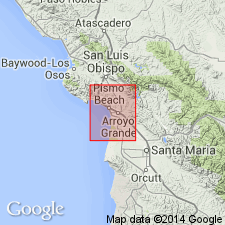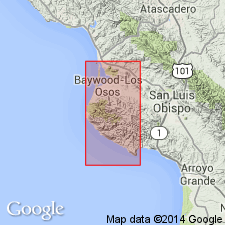
- Usage in publication:
-
- Squire Member
- Modifications:
-
- Named
- Dominant lithology:
-
- Sandstone
- AAPG geologic province:
-
- California Coast Ranges province
Summary:
Named as uppermost member (of 5) of Pismo Formation. Type section is exposures on south side of Squire Canyon within Pismo syncline [T31S R12E, Pismo Beach 7.5' quad] San Luis Obispo Co, CA. Consists of massive white or gray arkosic sandstone that is fine- to medium-grained, moderately well sorted, soft to hard, and friable. Unconformably overlies Belleview, Edna, or Miguelito Member (all new and of Pismo Formation). Locally overlaps Monterey Formation. Unconformably underlies Pas Robles(?) Formation. Age is late Pliocene based on marine megafossils.
Source: GNU records (USGS DDS-6; Menlo GNULEX).

- Usage in publication:
-
- Squire Member*
- Modifications:
-
- Adopted
- AAPG geologic province:
-
- California Coast Ranges province
Summary:
Squire Member of Pismo Formation of Hall (1973a) is adopted. Shown on geologic map of Morro Bay South and Port San Luis 7.5' quads, San Luis Obispo Co, CA. Contains LYROPECTEN CERROSENSIS (Gabb). Age is late Pliocene.
Source: GNU records (USGS DDS-6; Menlo GNULEX).
For more information, please contact Nancy Stamm, Geologic Names Committee Secretary.
Asterisk (*) indicates published by U.S. Geological Survey authors.
"No current usage" (†) implies that a name has been abandoned or has fallen into disuse. Former usage and, if known, replacement name given in parentheses ( ).
Slash (/) indicates name conflicts with nomenclatural guidelines (CSN, 1933; ACSN, 1961, 1970; NACSN, 1983, 2005, 2021). May be explained within brackets ([ ]).

